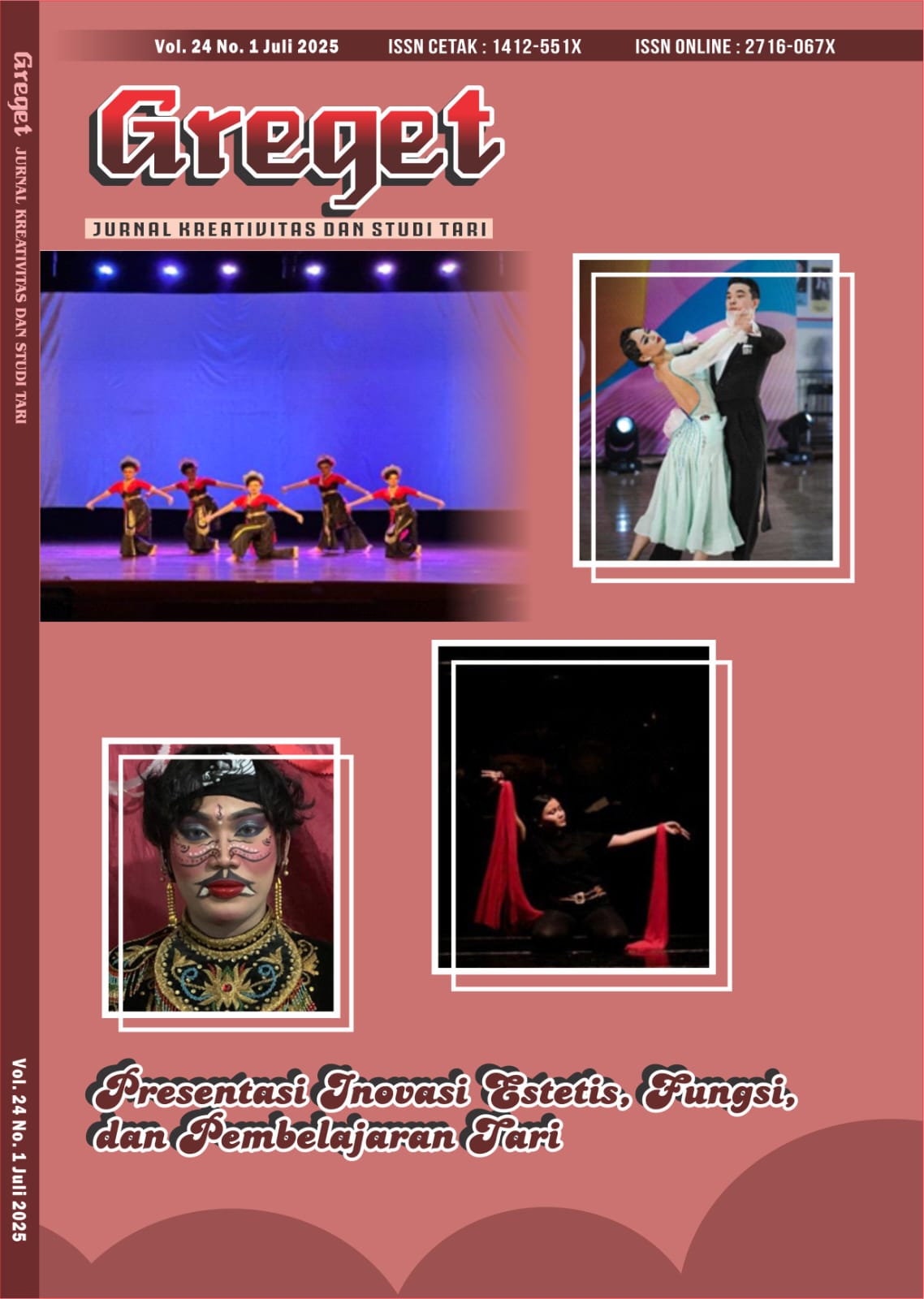PRESENTASI ESTETIS JARANAN SENTEREWE KOMUNITAS MANUNGGAL REKSO BUDOYO DALAM FESTIVAL JARANAN TRENGGALEK TAHUN 2023
Main Article Content
Abstract
This study examines the aesthetic presentation of the Jaranan Senterewe performance by the Manunggal Rekso Budoyo community at the 2023 Trenggalek Jaranan Festival. The research aims to analyze both the structural form and aesthetic components of the performance, using Sumandiyo Hadi’s theory of performance form and Doris Humphrey’s theory of performance aesthetics (as translated by Sal Murgiyanto). Employing a qualitative research method, data were collected through observation, interviews, and literature review. The findings indicate that the Jaranan Senterewe performance comprises distinctive elements such as dominant movements of the hands, feet, and head influenced by East Javanese traditions; a rigging stage as the performance space; pelog-based musical accompaniment with gendhing lancaran and sampak patterns; and a thematic emphasis on struggle and heroism. The performance features a group dance format with 14 male dancers, traditional costumes, bold makeup, neutral lighting, and symbolic props including kuda kepang, whips, Celeng, and Barongan. The aesthetic structure includes four main components: (1) Design, encompassing spatial formations and temporal sequencing; (2) Dynamics, involving variations in movement and musical intensity; (3) Rhythm, marked by traditional patterns such as mungkus and midak; and (4) Motivation, structured into opening, main, and closing sections. This study concludes that Jaranan Senterewe is a performance rich in symbolic meaning and artistic expression, contributing to the cultural vibrancy of East Javanese traditional arts.
Downloads
Article Details

This work is licensed under a Creative Commons Attribution-ShareAlike 4.0 International License.
Copyright
Authors who publish with GREGET agrees to the following terms:
- Authors retain copyright and grant the journal right of first publication with the work simultaneously licensed under a Creative Commons Attribution-ShareAlike 4.0 (CC BY-SA 4.0) that allows others to share the work with an acknowledgment of the work's authorship and initial publication in this journal.
- Authors are able to enter into separate, additional contractual arrangements for the non-exclusive distribution of the journal's published version of the work (e.g., post it to an institutional repository or publish it in a book), with an acknowledgment of its initial publication in this journal.
- Authors are permitted and encouraged to post their work online (e.g., in institutional repositories or on their website) prior to and during the submission process, as it can lead to productive exchanges, as well as earlier and greater citation of published work.
References
Aini, Miza. (2022). Kesenian Jaranan KPK (Kridho Panji Kusumo) Kota Blitar Sebagai Simbol Makna Kultural (Sebuah Studi Linguistik Antropologi). Jurnal Keilmuan Bahasa, Sastra dan Pengajarannya, 3(1).
Alfahmi, Nesty. (2021). Analisis Gerak Tari Pada Grub Jaranan Satrio Putro Kencono di Kabupaten Trenggalek. Jurnal Pemikiran Seni Pertunjukan, 9(2).
Diah, Rizky. (2024). Eksplorasi Fungsi Pertunjukan Kesenian Jaranan Sebagai Warisan Budaya Masyarakat Dusun Ngandeng. Jurnal UPT. Bahasa, Universitas Dharmawangsa, 1(2). https://jurnal.dharmawangsa.ac.id/index.php/dialect/article/view/4632
Hadi, Y Sumandiyo. (2003). Aspek-Aspek Dasar Koreografi Kelompok. Yogyakarta: LKAPHI.
Hadi, Y Sumandiyo. (2007). Kajian Tari Teks dan Konteks. Yogyakarta: Pustaka Book Publisher.
Jaya, Indra. (2017). Kesenian Jaranan Senterewe di Tulungagung Tahun 1958-1986. Avatara: Jurnal Pendidikan Sejarah, 5(3). https://ejournal.unesa.ac.id/index.php/avatara/article/view/20086
Murgiyanto, Sal. (1983). Seni Menata Tari. Jakarta: Dewan Kesenian Jakarta.
Nareswari, Uli Rizky. (2014). Analisis Struktural Jaranan Senterewe Turangga Wijaya di Dusun Sorogenen, Kecamatan Kalasan, Kabupaten Sleman, Yogyakarta [Skripsi Jurusan Tari, Fakultas Seni Pertunjukan, Institut Seni Indonesia (ISI) Yogyakarta].
Regiagita, Delonix. (2023). Pembelajaran Tari Jaranan Senterewe untuk Anak-Anak dengan Metode Nyacah di Sanggar Seni Prana Kesuma Aji. Jurnal Pendidikan Sendratasik, 12(1). https://ejournal.unesa.ac.id/index.php/jurnal-pendidikan-sendratasik/article/view/46437
Soedarsono. (1978). Pengantar dan Komposisi Tari. Yogyakarta: Akademi Seni Tari Indonesia.
Sugiyono. (2009). Metode Penelitian Pendekatan Kualitatif, dan R&D. Bandung: Alfabeta.
